Analyzing Risk in Audit of Financial Reports: JB HI FI Limited
VerifiedAdded on 2023/03/23
|10
|3232
|65
AI Summary
This assignment aims to understand a company and analytically analyse the risk involved in the audit of such financial reports, it contain a detailed explanation on the analysis of the analytical procedures performed on the company
Contribute Materials
Your contribution can guide someone’s learning journey. Share your
documents today.
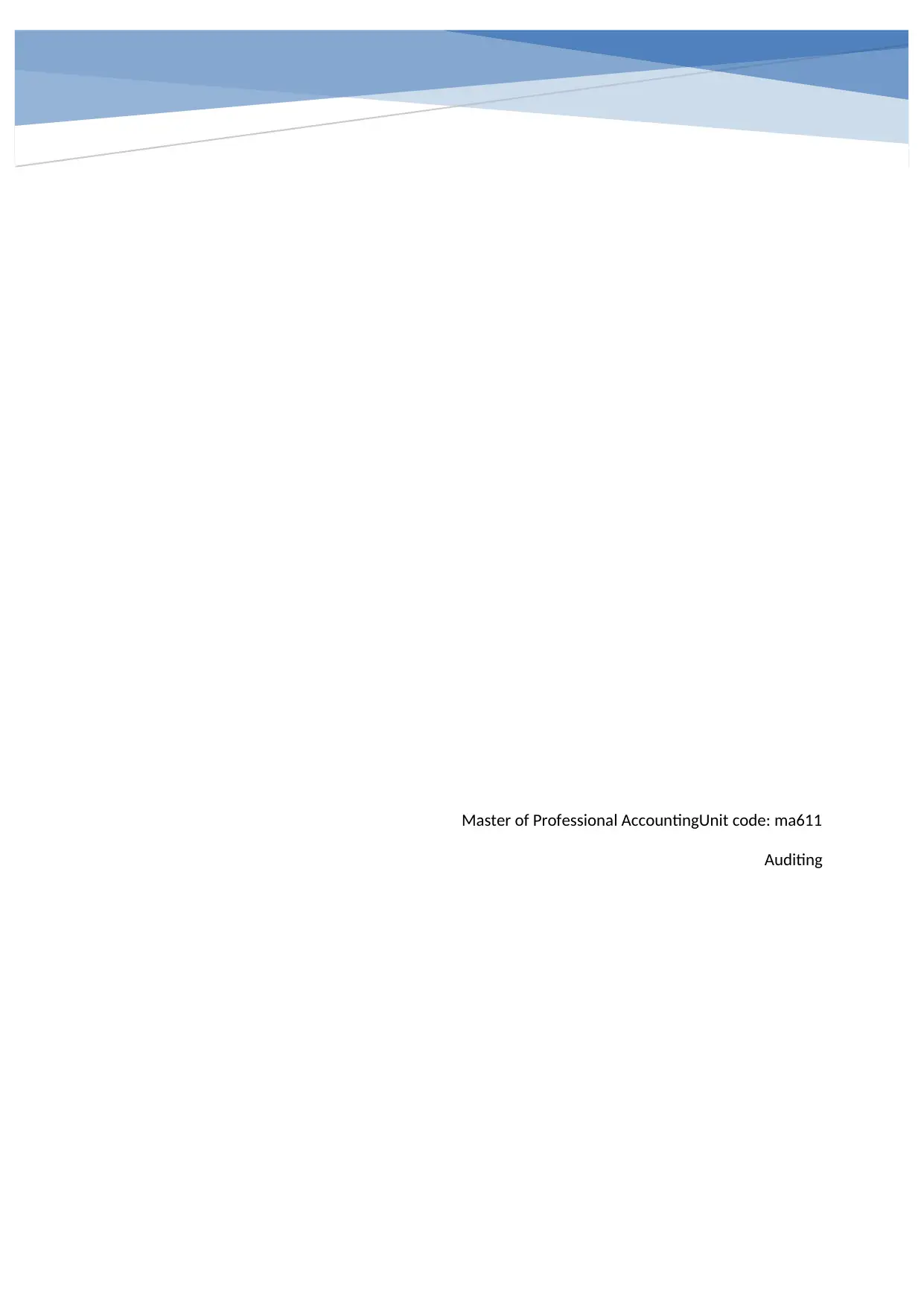
Master of Professional AccountingUnit code: ma611
Auditing
Auditing
Secure Best Marks with AI Grader
Need help grading? Try our AI Grader for instant feedback on your assignments.
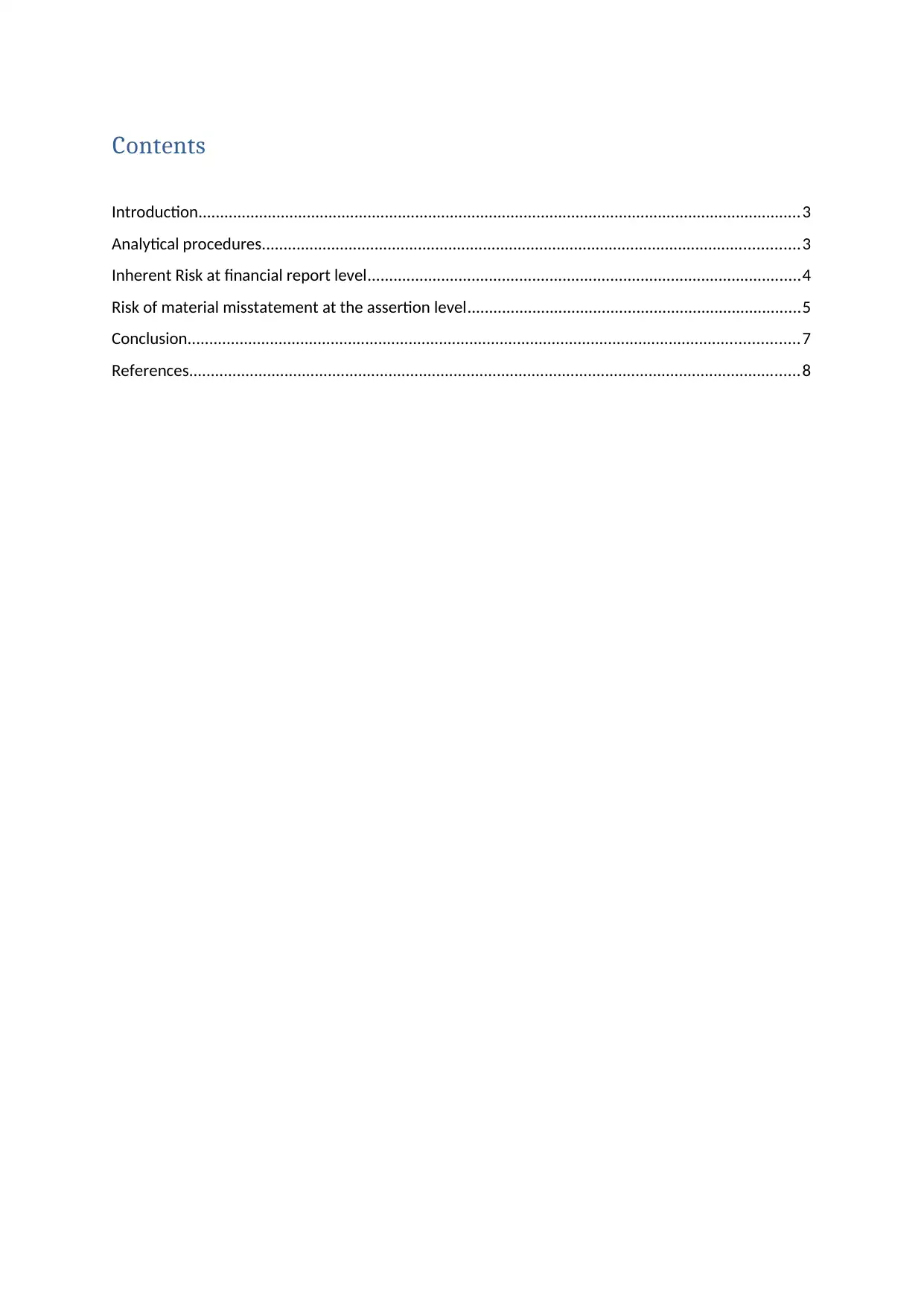
Contents
Introduction...........................................................................................................................................3
Analytical procedures............................................................................................................................3
Inherent Risk at financial report level....................................................................................................4
Risk of material misstatement at the assertion level.............................................................................5
Conclusion.............................................................................................................................................7
References.............................................................................................................................................8
Introduction...........................................................................................................................................3
Analytical procedures............................................................................................................................3
Inherent Risk at financial report level....................................................................................................4
Risk of material misstatement at the assertion level.............................................................................5
Conclusion.............................................................................................................................................7
References.............................................................................................................................................8

Executive Summary
This assignment aims to understand a company and analytically analyse the risk involved in the audit
of such financial reports, it contain a detailed explanation on the analysis of the analytical
procedures performed on the company,
The inherent risk is estimated / assessed at both the financial reporting level where the control risk
and detection risk of material misstatements are identified and understood,
The risk involved at the level of assertions is made in a given format according to the nature of such
risk at such levels including a brief review of such assertions that can be taken while performing the
audit of such company.
Audit risk based on the risk of material misstatements due to the limitations of conducting an audit
is made in accordance with the available information of the company.
Three key account balances that could affect the risk of assertions are taken into consideration by
analysing the information present in the annual report of the company and steps to reduce such risk
through internal controls is provided to enhance the quality of audit.
The points considered in the assignment are based on the articles and annual report that are
published by the company in the website of the company JB HIFI LIMITED.
This assignment aims to understand a company and analytically analyse the risk involved in the audit
of such financial reports, it contain a detailed explanation on the analysis of the analytical
procedures performed on the company,
The inherent risk is estimated / assessed at both the financial reporting level where the control risk
and detection risk of material misstatements are identified and understood,
The risk involved at the level of assertions is made in a given format according to the nature of such
risk at such levels including a brief review of such assertions that can be taken while performing the
audit of such company.
Audit risk based on the risk of material misstatements due to the limitations of conducting an audit
is made in accordance with the available information of the company.
Three key account balances that could affect the risk of assertions are taken into consideration by
analysing the information present in the annual report of the company and steps to reduce such risk
through internal controls is provided to enhance the quality of audit.
The points considered in the assignment are based on the articles and annual report that are
published by the company in the website of the company JB HIFI LIMITED.
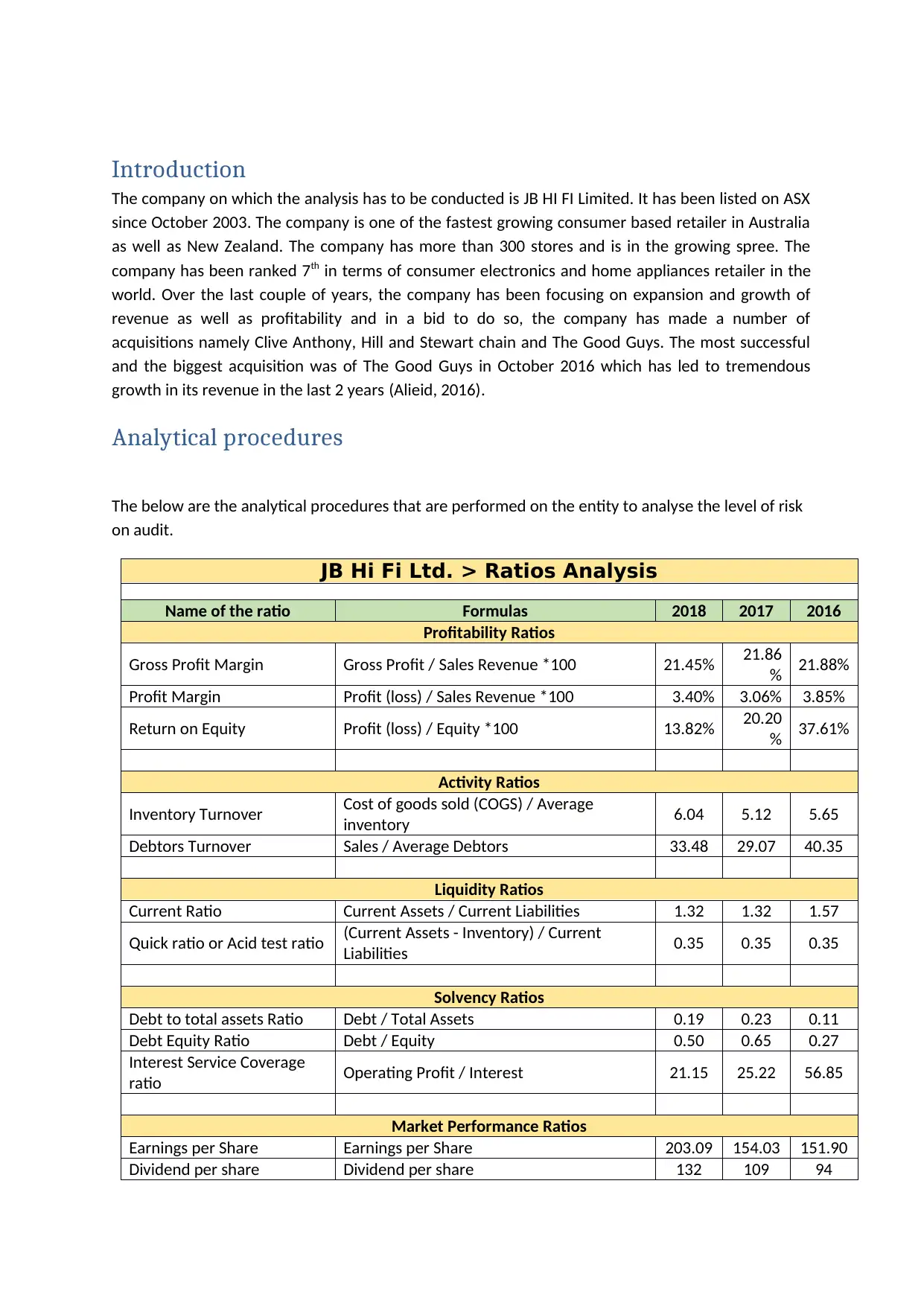
Introduction
The company on which the analysis has to be conducted is JB HI FI Limited. It has been listed on ASX
since October 2003. The company is one of the fastest growing consumer based retailer in Australia
as well as New Zealand. The company has more than 300 stores and is in the growing spree. The
company has been ranked 7th in terms of consumer electronics and home appliances retailer in the
world. Over the last couple of years, the company has been focusing on expansion and growth of
revenue as well as profitability and in a bid to do so, the company has made a number of
acquisitions namely Clive Anthony, Hill and Stewart chain and The Good Guys. The most successful
and the biggest acquisition was of The Good Guys in October 2016 which has led to tremendous
growth in its revenue in the last 2 years (Alieid, 2016).
Analytical procedures
The below are the analytical procedures that are performed on the entity to analyse the level of risk
on audit.
JB Hi Fi Ltd. > Ratios Analysis
Name of the ratio Formulas 2018 2017 2016
Profitability Ratios
Gross Profit Margin Gross Profit / Sales Revenue *100 21.45% 21.86
% 21.88%
Profit Margin Profit (loss) / Sales Revenue *100 3.40% 3.06% 3.85%
Return on Equity Profit (loss) / Equity *100 13.82% 20.20
% 37.61%
Activity Ratios
Inventory Turnover Cost of goods sold (COGS) / Average
inventory 6.04 5.12 5.65
Debtors Turnover Sales / Average Debtors 33.48 29.07 40.35
Liquidity Ratios
Current Ratio Current Assets / Current Liabilities 1.32 1.32 1.57
Quick ratio or Acid test ratio (Current Assets - Inventory) / Current
Liabilities 0.35 0.35 0.35
Solvency Ratios
Debt to total assets Ratio Debt / Total Assets 0.19 0.23 0.11
Debt Equity Ratio Debt / Equity 0.50 0.65 0.27
Interest Service Coverage
ratio Operating Profit / Interest 21.15 25.22 56.85
Market Performance Ratios
Earnings per Share Earnings per Share 203.09 154.03 151.90
Dividend per share Dividend per share 132 109 94
The company on which the analysis has to be conducted is JB HI FI Limited. It has been listed on ASX
since October 2003. The company is one of the fastest growing consumer based retailer in Australia
as well as New Zealand. The company has more than 300 stores and is in the growing spree. The
company has been ranked 7th in terms of consumer electronics and home appliances retailer in the
world. Over the last couple of years, the company has been focusing on expansion and growth of
revenue as well as profitability and in a bid to do so, the company has made a number of
acquisitions namely Clive Anthony, Hill and Stewart chain and The Good Guys. The most successful
and the biggest acquisition was of The Good Guys in October 2016 which has led to tremendous
growth in its revenue in the last 2 years (Alieid, 2016).
Analytical procedures
The below are the analytical procedures that are performed on the entity to analyse the level of risk
on audit.
JB Hi Fi Ltd. > Ratios Analysis
Name of the ratio Formulas 2018 2017 2016
Profitability Ratios
Gross Profit Margin Gross Profit / Sales Revenue *100 21.45% 21.86
% 21.88%
Profit Margin Profit (loss) / Sales Revenue *100 3.40% 3.06% 3.85%
Return on Equity Profit (loss) / Equity *100 13.82% 20.20
% 37.61%
Activity Ratios
Inventory Turnover Cost of goods sold (COGS) / Average
inventory 6.04 5.12 5.65
Debtors Turnover Sales / Average Debtors 33.48 29.07 40.35
Liquidity Ratios
Current Ratio Current Assets / Current Liabilities 1.32 1.32 1.57
Quick ratio or Acid test ratio (Current Assets - Inventory) / Current
Liabilities 0.35 0.35 0.35
Solvency Ratios
Debt to total assets Ratio Debt / Total Assets 0.19 0.23 0.11
Debt Equity Ratio Debt / Equity 0.50 0.65 0.27
Interest Service Coverage
ratio Operating Profit / Interest 21.15 25.22 56.85
Market Performance Ratios
Earnings per Share Earnings per Share 203.09 154.03 151.90
Dividend per share Dividend per share 132 109 94
Secure Best Marks with AI Grader
Need help grading? Try our AI Grader for instant feedback on your assignments.
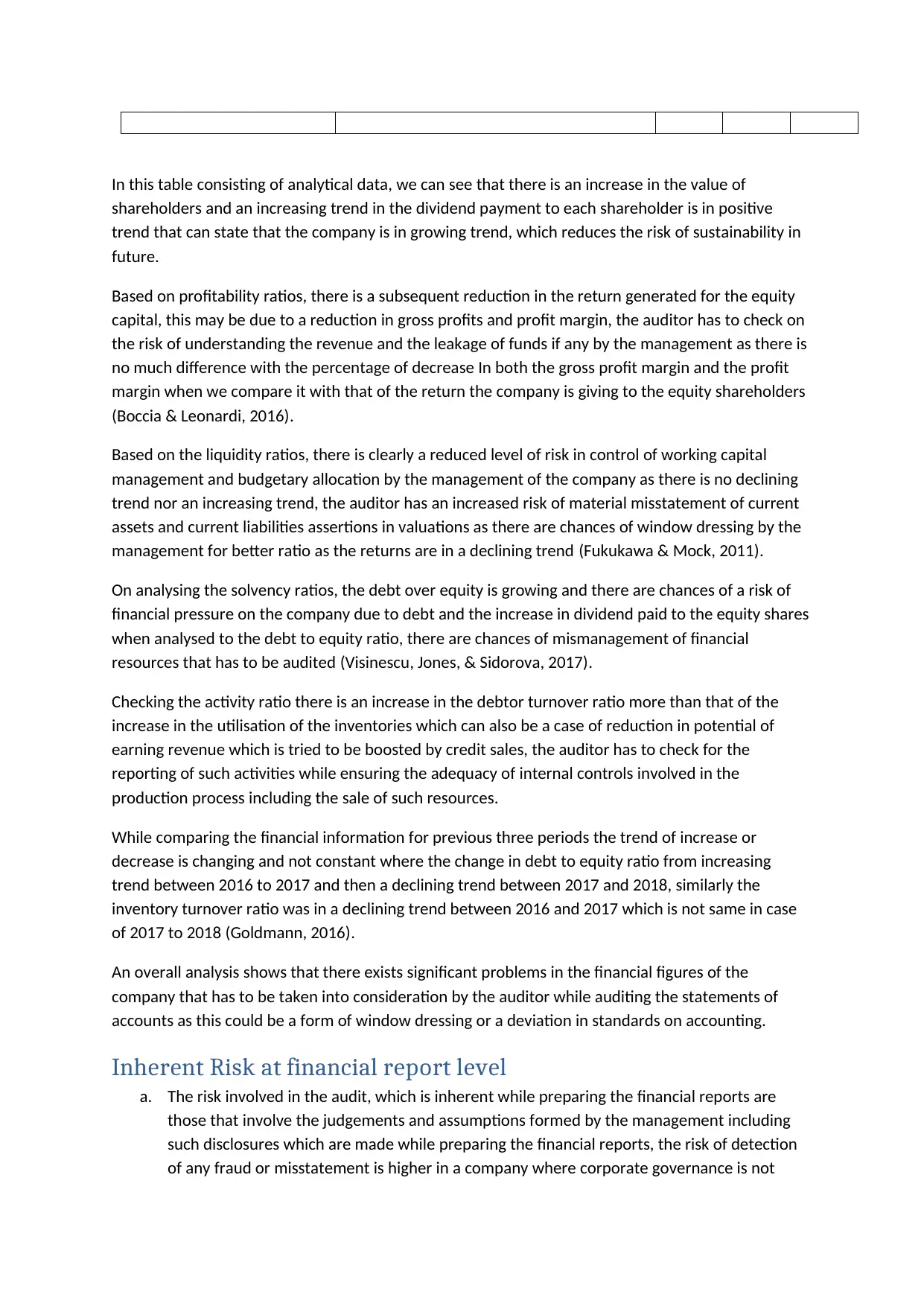
In this table consisting of analytical data, we can see that there is an increase in the value of
shareholders and an increasing trend in the dividend payment to each shareholder is in positive
trend that can state that the company is in growing trend, which reduces the risk of sustainability in
future.
Based on profitability ratios, there is a subsequent reduction in the return generated for the equity
capital, this may be due to a reduction in gross profits and profit margin, the auditor has to check on
the risk of understanding the revenue and the leakage of funds if any by the management as there is
no much difference with the percentage of decrease In both the gross profit margin and the profit
margin when we compare it with that of the return the company is giving to the equity shareholders
(Boccia & Leonardi, 2016).
Based on the liquidity ratios, there is clearly a reduced level of risk in control of working capital
management and budgetary allocation by the management of the company as there is no declining
trend nor an increasing trend, the auditor has an increased risk of material misstatement of current
assets and current liabilities assertions in valuations as there are chances of window dressing by the
management for better ratio as the returns are in a declining trend (Fukukawa & Mock, 2011).
On analysing the solvency ratios, the debt over equity is growing and there are chances of a risk of
financial pressure on the company due to debt and the increase in dividend paid to the equity shares
when analysed to the debt to equity ratio, there are chances of mismanagement of financial
resources that has to be audited (Visinescu, Jones, & Sidorova, 2017).
Checking the activity ratio there is an increase in the debtor turnover ratio more than that of the
increase in the utilisation of the inventories which can also be a case of reduction in potential of
earning revenue which is tried to be boosted by credit sales, the auditor has to check for the
reporting of such activities while ensuring the adequacy of internal controls involved in the
production process including the sale of such resources.
While comparing the financial information for previous three periods the trend of increase or
decrease is changing and not constant where the change in debt to equity ratio from increasing
trend between 2016 to 2017 and then a declining trend between 2017 and 2018, similarly the
inventory turnover ratio was in a declining trend between 2016 and 2017 which is not same in case
of 2017 to 2018 (Goldmann, 2016).
An overall analysis shows that there exists significant problems in the financial figures of the
company that has to be taken into consideration by the auditor while auditing the statements of
accounts as this could be a form of window dressing or a deviation in standards on accounting.
Inherent Risk at financial report level
a. The risk involved in the audit, which is inherent while preparing the financial reports are
those that involve the judgements and assumptions formed by the management including
such disclosures which are made while preparing the financial reports, the risk of detection
of any fraud or misstatement is higher in a company where corporate governance is not
shareholders and an increasing trend in the dividend payment to each shareholder is in positive
trend that can state that the company is in growing trend, which reduces the risk of sustainability in
future.
Based on profitability ratios, there is a subsequent reduction in the return generated for the equity
capital, this may be due to a reduction in gross profits and profit margin, the auditor has to check on
the risk of understanding the revenue and the leakage of funds if any by the management as there is
no much difference with the percentage of decrease In both the gross profit margin and the profit
margin when we compare it with that of the return the company is giving to the equity shareholders
(Boccia & Leonardi, 2016).
Based on the liquidity ratios, there is clearly a reduced level of risk in control of working capital
management and budgetary allocation by the management of the company as there is no declining
trend nor an increasing trend, the auditor has an increased risk of material misstatement of current
assets and current liabilities assertions in valuations as there are chances of window dressing by the
management for better ratio as the returns are in a declining trend (Fukukawa & Mock, 2011).
On analysing the solvency ratios, the debt over equity is growing and there are chances of a risk of
financial pressure on the company due to debt and the increase in dividend paid to the equity shares
when analysed to the debt to equity ratio, there are chances of mismanagement of financial
resources that has to be audited (Visinescu, Jones, & Sidorova, 2017).
Checking the activity ratio there is an increase in the debtor turnover ratio more than that of the
increase in the utilisation of the inventories which can also be a case of reduction in potential of
earning revenue which is tried to be boosted by credit sales, the auditor has to check for the
reporting of such activities while ensuring the adequacy of internal controls involved in the
production process including the sale of such resources.
While comparing the financial information for previous three periods the trend of increase or
decrease is changing and not constant where the change in debt to equity ratio from increasing
trend between 2016 to 2017 and then a declining trend between 2017 and 2018, similarly the
inventory turnover ratio was in a declining trend between 2016 and 2017 which is not same in case
of 2017 to 2018 (Goldmann, 2016).
An overall analysis shows that there exists significant problems in the financial figures of the
company that has to be taken into consideration by the auditor while auditing the statements of
accounts as this could be a form of window dressing or a deviation in standards on accounting.
Inherent Risk at financial report level
a. The risk involved in the audit, which is inherent while preparing the financial reports are
those that involve the judgements and assumptions formed by the management including
such disclosures which are made while preparing the financial reports, the risk of detection
of any fraud or misstatement is higher in a company where corporate governance is not
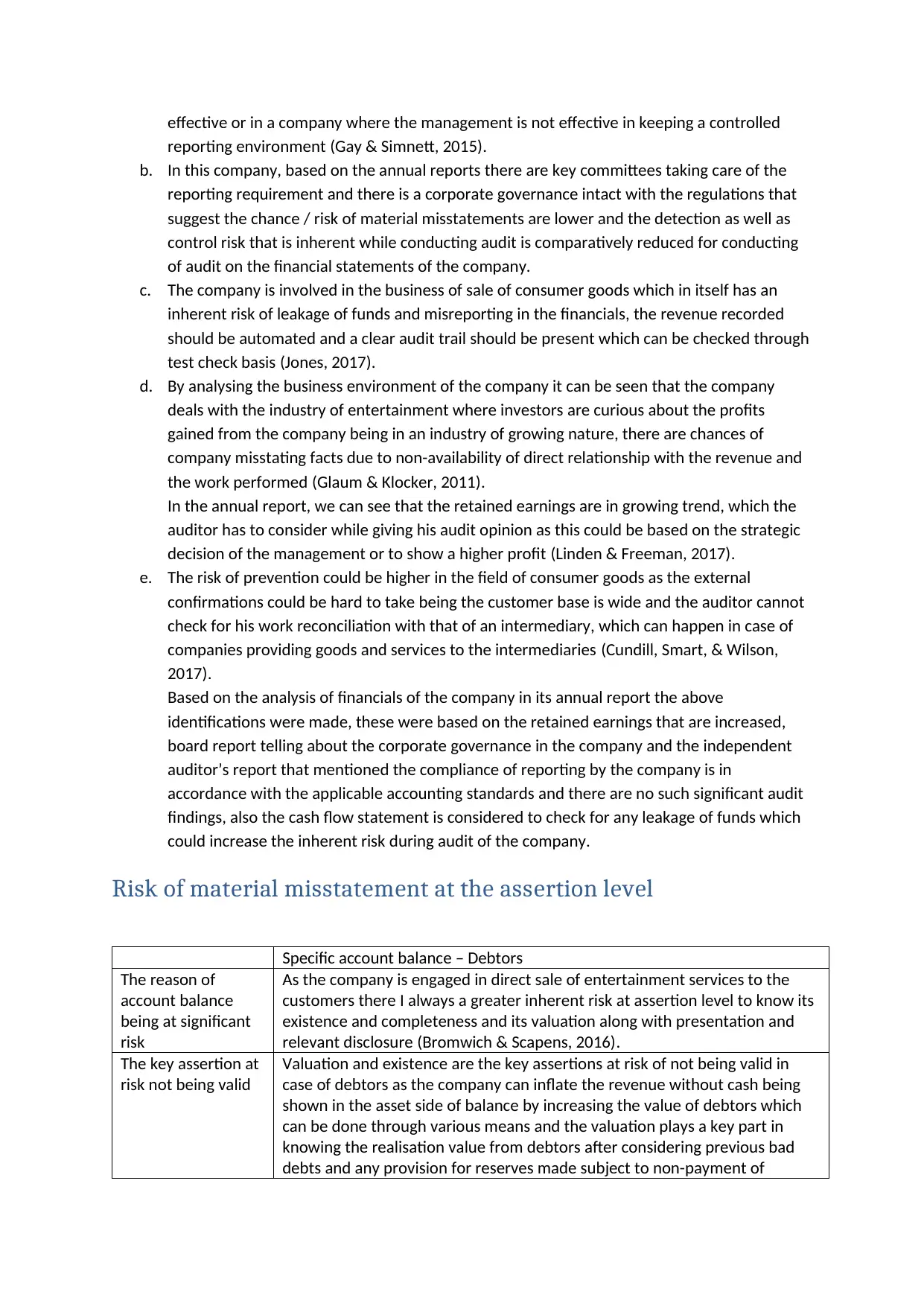
effective or in a company where the management is not effective in keeping a controlled
reporting environment (Gay & Simnett, 2015).
b. In this company, based on the annual reports there are key committees taking care of the
reporting requirement and there is a corporate governance intact with the regulations that
suggest the chance / risk of material misstatements are lower and the detection as well as
control risk that is inherent while conducting audit is comparatively reduced for conducting
of audit on the financial statements of the company.
c. The company is involved in the business of sale of consumer goods which in itself has an
inherent risk of leakage of funds and misreporting in the financials, the revenue recorded
should be automated and a clear audit trail should be present which can be checked through
test check basis (Jones, 2017).
d. By analysing the business environment of the company it can be seen that the company
deals with the industry of entertainment where investors are curious about the profits
gained from the company being in an industry of growing nature, there are chances of
company misstating facts due to non-availability of direct relationship with the revenue and
the work performed (Glaum & Klocker, 2011).
In the annual report, we can see that the retained earnings are in growing trend, which the
auditor has to consider while giving his audit opinion as this could be based on the strategic
decision of the management or to show a higher profit (Linden & Freeman, 2017).
e. The risk of prevention could be higher in the field of consumer goods as the external
confirmations could be hard to take being the customer base is wide and the auditor cannot
check for his work reconciliation with that of an intermediary, which can happen in case of
companies providing goods and services to the intermediaries (Cundill, Smart, & Wilson,
2017).
Based on the analysis of financials of the company in its annual report the above
identifications were made, these were based on the retained earnings that are increased,
board report telling about the corporate governance in the company and the independent
auditor’s report that mentioned the compliance of reporting by the company is in
accordance with the applicable accounting standards and there are no such significant audit
findings, also the cash flow statement is considered to check for any leakage of funds which
could increase the inherent risk during audit of the company.
Risk of material misstatement at the assertion level
Specific account balance – Debtors
The reason of
account balance
being at significant
risk
As the company is engaged in direct sale of entertainment services to the
customers there I always a greater inherent risk at assertion level to know its
existence and completeness and its valuation along with presentation and
relevant disclosure (Bromwich & Scapens, 2016).
The key assertion at
risk not being valid
Valuation and existence are the key assertions at risk of not being valid in
case of debtors as the company can inflate the revenue without cash being
shown in the asset side of balance by increasing the value of debtors which
can be done through various means and the valuation plays a key part in
knowing the realisation value from debtors after considering previous bad
debts and any provision for reserves made subject to non-payment of
reporting environment (Gay & Simnett, 2015).
b. In this company, based on the annual reports there are key committees taking care of the
reporting requirement and there is a corporate governance intact with the regulations that
suggest the chance / risk of material misstatements are lower and the detection as well as
control risk that is inherent while conducting audit is comparatively reduced for conducting
of audit on the financial statements of the company.
c. The company is involved in the business of sale of consumer goods which in itself has an
inherent risk of leakage of funds and misreporting in the financials, the revenue recorded
should be automated and a clear audit trail should be present which can be checked through
test check basis (Jones, 2017).
d. By analysing the business environment of the company it can be seen that the company
deals with the industry of entertainment where investors are curious about the profits
gained from the company being in an industry of growing nature, there are chances of
company misstating facts due to non-availability of direct relationship with the revenue and
the work performed (Glaum & Klocker, 2011).
In the annual report, we can see that the retained earnings are in growing trend, which the
auditor has to consider while giving his audit opinion as this could be based on the strategic
decision of the management or to show a higher profit (Linden & Freeman, 2017).
e. The risk of prevention could be higher in the field of consumer goods as the external
confirmations could be hard to take being the customer base is wide and the auditor cannot
check for his work reconciliation with that of an intermediary, which can happen in case of
companies providing goods and services to the intermediaries (Cundill, Smart, & Wilson,
2017).
Based on the analysis of financials of the company in its annual report the above
identifications were made, these were based on the retained earnings that are increased,
board report telling about the corporate governance in the company and the independent
auditor’s report that mentioned the compliance of reporting by the company is in
accordance with the applicable accounting standards and there are no such significant audit
findings, also the cash flow statement is considered to check for any leakage of funds which
could increase the inherent risk during audit of the company.
Risk of material misstatement at the assertion level
Specific account balance – Debtors
The reason of
account balance
being at significant
risk
As the company is engaged in direct sale of entertainment services to the
customers there I always a greater inherent risk at assertion level to know its
existence and completeness and its valuation along with presentation and
relevant disclosure (Bromwich & Scapens, 2016).
The key assertion at
risk not being valid
Valuation and existence are the key assertions at risk of not being valid in
case of debtors as the company can inflate the revenue without cash being
shown in the asset side of balance by increasing the value of debtors which
can be done through various means and the valuation plays a key part in
knowing the realisation value from debtors after considering previous bad
debts and any provision for reserves made subject to non-payment of
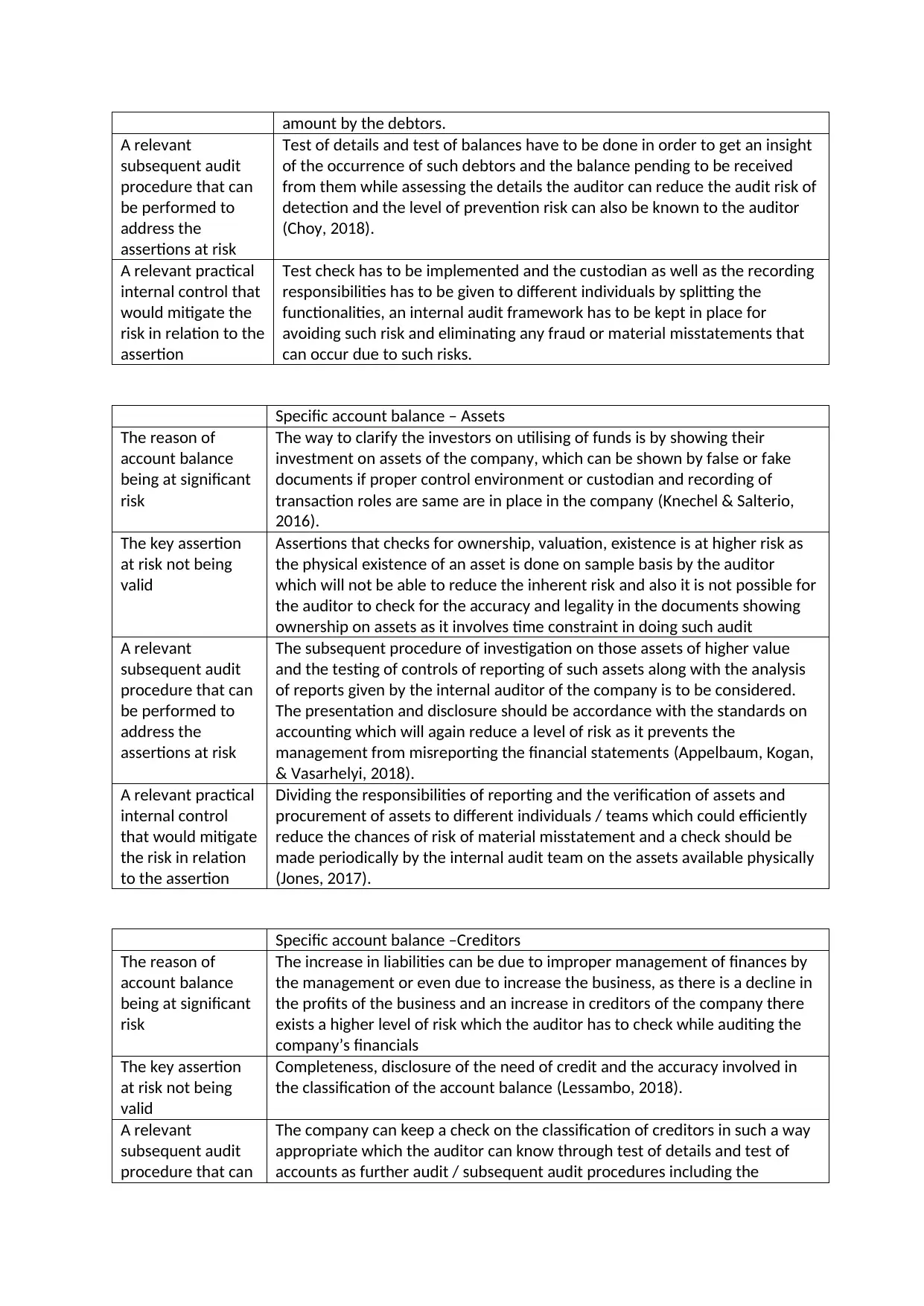
amount by the debtors.
A relevant
subsequent audit
procedure that can
be performed to
address the
assertions at risk
Test of details and test of balances have to be done in order to get an insight
of the occurrence of such debtors and the balance pending to be received
from them while assessing the details the auditor can reduce the audit risk of
detection and the level of prevention risk can also be known to the auditor
(Choy, 2018).
A relevant practical
internal control that
would mitigate the
risk in relation to the
assertion
Test check has to be implemented and the custodian as well as the recording
responsibilities has to be given to different individuals by splitting the
functionalities, an internal audit framework has to be kept in place for
avoiding such risk and eliminating any fraud or material misstatements that
can occur due to such risks.
Specific account balance – Assets
The reason of
account balance
being at significant
risk
The way to clarify the investors on utilising of funds is by showing their
investment on assets of the company, which can be shown by false or fake
documents if proper control environment or custodian and recording of
transaction roles are same are in place in the company (Knechel & Salterio,
2016).
The key assertion
at risk not being
valid
Assertions that checks for ownership, valuation, existence is at higher risk as
the physical existence of an asset is done on sample basis by the auditor
which will not be able to reduce the inherent risk and also it is not possible for
the auditor to check for the accuracy and legality in the documents showing
ownership on assets as it involves time constraint in doing such audit
A relevant
subsequent audit
procedure that can
be performed to
address the
assertions at risk
The subsequent procedure of investigation on those assets of higher value
and the testing of controls of reporting of such assets along with the analysis
of reports given by the internal auditor of the company is to be considered.
The presentation and disclosure should be accordance with the standards on
accounting which will again reduce a level of risk as it prevents the
management from misreporting the financial statements (Appelbaum, Kogan,
& Vasarhelyi, 2018).
A relevant practical
internal control
that would mitigate
the risk in relation
to the assertion
Dividing the responsibilities of reporting and the verification of assets and
procurement of assets to different individuals / teams which could efficiently
reduce the chances of risk of material misstatement and a check should be
made periodically by the internal audit team on the assets available physically
(Jones, 2017).
Specific account balance –Creditors
The reason of
account balance
being at significant
risk
The increase in liabilities can be due to improper management of finances by
the management or even due to increase the business, as there is a decline in
the profits of the business and an increase in creditors of the company there
exists a higher level of risk which the auditor has to check while auditing the
company’s financials
The key assertion
at risk not being
valid
Completeness, disclosure of the need of credit and the accuracy involved in
the classification of the account balance (Lessambo, 2018).
A relevant
subsequent audit
procedure that can
The company can keep a check on the classification of creditors in such a way
appropriate which the auditor can know through test of details and test of
accounts as further audit / subsequent audit procedures including the
A relevant
subsequent audit
procedure that can
be performed to
address the
assertions at risk
Test of details and test of balances have to be done in order to get an insight
of the occurrence of such debtors and the balance pending to be received
from them while assessing the details the auditor can reduce the audit risk of
detection and the level of prevention risk can also be known to the auditor
(Choy, 2018).
A relevant practical
internal control that
would mitigate the
risk in relation to the
assertion
Test check has to be implemented and the custodian as well as the recording
responsibilities has to be given to different individuals by splitting the
functionalities, an internal audit framework has to be kept in place for
avoiding such risk and eliminating any fraud or material misstatements that
can occur due to such risks.
Specific account balance – Assets
The reason of
account balance
being at significant
risk
The way to clarify the investors on utilising of funds is by showing their
investment on assets of the company, which can be shown by false or fake
documents if proper control environment or custodian and recording of
transaction roles are same are in place in the company (Knechel & Salterio,
2016).
The key assertion
at risk not being
valid
Assertions that checks for ownership, valuation, existence is at higher risk as
the physical existence of an asset is done on sample basis by the auditor
which will not be able to reduce the inherent risk and also it is not possible for
the auditor to check for the accuracy and legality in the documents showing
ownership on assets as it involves time constraint in doing such audit
A relevant
subsequent audit
procedure that can
be performed to
address the
assertions at risk
The subsequent procedure of investigation on those assets of higher value
and the testing of controls of reporting of such assets along with the analysis
of reports given by the internal auditor of the company is to be considered.
The presentation and disclosure should be accordance with the standards on
accounting which will again reduce a level of risk as it prevents the
management from misreporting the financial statements (Appelbaum, Kogan,
& Vasarhelyi, 2018).
A relevant practical
internal control
that would mitigate
the risk in relation
to the assertion
Dividing the responsibilities of reporting and the verification of assets and
procurement of assets to different individuals / teams which could efficiently
reduce the chances of risk of material misstatement and a check should be
made periodically by the internal audit team on the assets available physically
(Jones, 2017).
Specific account balance –Creditors
The reason of
account balance
being at significant
risk
The increase in liabilities can be due to improper management of finances by
the management or even due to increase the business, as there is a decline in
the profits of the business and an increase in creditors of the company there
exists a higher level of risk which the auditor has to check while auditing the
company’s financials
The key assertion
at risk not being
valid
Completeness, disclosure of the need of credit and the accuracy involved in
the classification of the account balance (Lessambo, 2018).
A relevant
subsequent audit
procedure that can
The company can keep a check on the classification of creditors in such a way
appropriate which the auditor can know through test of details and test of
accounts as further audit / subsequent audit procedures including the
Paraphrase This Document
Need a fresh take? Get an instant paraphrase of this document with our AI Paraphraser
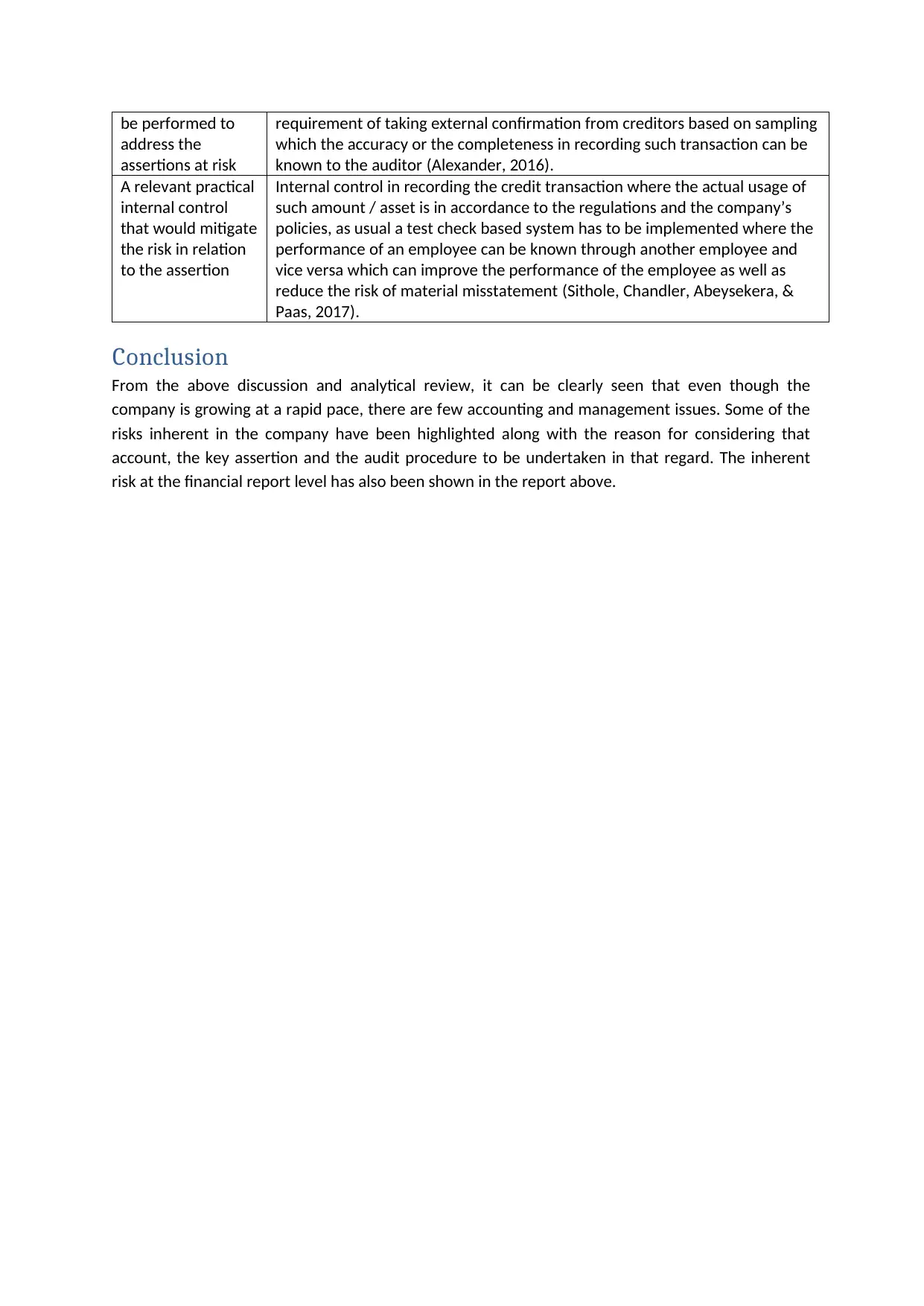
be performed to
address the
assertions at risk
requirement of taking external confirmation from creditors based on sampling
which the accuracy or the completeness in recording such transaction can be
known to the auditor (Alexander, 2016).
A relevant practical
internal control
that would mitigate
the risk in relation
to the assertion
Internal control in recording the credit transaction where the actual usage of
such amount / asset is in accordance to the regulations and the company’s
policies, as usual a test check based system has to be implemented where the
performance of an employee can be known through another employee and
vice versa which can improve the performance of the employee as well as
reduce the risk of material misstatement (Sithole, Chandler, Abeysekera, &
Paas, 2017).
Conclusion
From the above discussion and analytical review, it can be clearly seen that even though the
company is growing at a rapid pace, there are few accounting and management issues. Some of the
risks inherent in the company have been highlighted along with the reason for considering that
account, the key assertion and the audit procedure to be undertaken in that regard. The inherent
risk at the financial report level has also been shown in the report above.
address the
assertions at risk
requirement of taking external confirmation from creditors based on sampling
which the accuracy or the completeness in recording such transaction can be
known to the auditor (Alexander, 2016).
A relevant practical
internal control
that would mitigate
the risk in relation
to the assertion
Internal control in recording the credit transaction where the actual usage of
such amount / asset is in accordance to the regulations and the company’s
policies, as usual a test check based system has to be implemented where the
performance of an employee can be known through another employee and
vice versa which can improve the performance of the employee as well as
reduce the risk of material misstatement (Sithole, Chandler, Abeysekera, &
Paas, 2017).
Conclusion
From the above discussion and analytical review, it can be clearly seen that even though the
company is growing at a rapid pace, there are few accounting and management issues. Some of the
risks inherent in the company have been highlighted along with the reason for considering that
account, the key assertion and the audit procedure to be undertaken in that regard. The inherent
risk at the financial report level has also been shown in the report above.
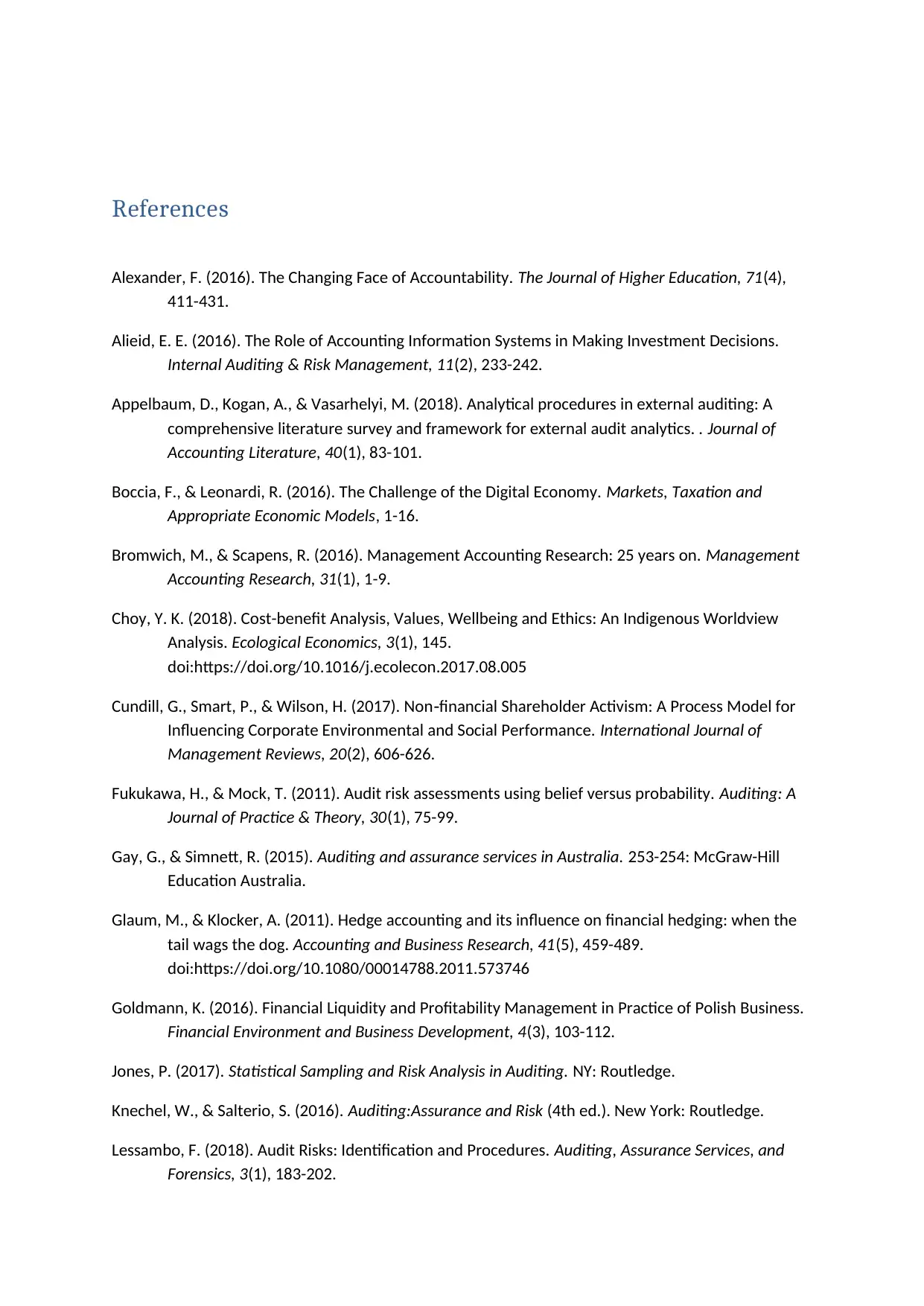
References
Alexander, F. (2016). The Changing Face of Accountability. The Journal of Higher Education, 71(4),
411-431.
Alieid, E. E. (2016). The Role of Accounting Information Systems in Making Investment Decisions.
Internal Auditing & Risk Management, 11(2), 233-242.
Appelbaum, D., Kogan, A., & Vasarhelyi, M. (2018). Analytical procedures in external auditing: A
comprehensive literature survey and framework for external audit analytics. . Journal of
Accounting Literature, 40(1), 83-101.
Boccia, F., & Leonardi, R. (2016). The Challenge of the Digital Economy. Markets, Taxation and
Appropriate Economic Models, 1-16.
Bromwich, M., & Scapens, R. (2016). Management Accounting Research: 25 years on. Management
Accounting Research, 31(1), 1-9.
Choy, Y. K. (2018). Cost-benefit Analysis, Values, Wellbeing and Ethics: An Indigenous Worldview
Analysis. Ecological Economics, 3(1), 145.
doi:https://doi.org/10.1016/j.ecolecon.2017.08.005
Cundill, G., Smart, P., & Wilson, H. (2017). Non financial Shareholder Activism: A Process Model for‐
Influencing Corporate Environmental and Social Performance. International Journal of
Management Reviews, 20(2), 606-626.
Fukukawa, H., & Mock, T. (2011). Audit risk assessments using belief versus probability. Auditing: A
Journal of Practice & Theory, 30(1), 75-99.
Gay, G., & Simnett, R. (2015). Auditing and assurance services in Australia. 253-254: McGraw-Hill
Education Australia.
Glaum, M., & Klocker, A. (2011). Hedge accounting and its influence on financial hedging: when the
tail wags the dog. Accounting and Business Research, 41(5), 459-489.
doi:https://doi.org/10.1080/00014788.2011.573746
Goldmann, K. (2016). Financial Liquidity and Profitability Management in Practice of Polish Business.
Financial Environment and Business Development, 4(3), 103-112.
Jones, P. (2017). Statistical Sampling and Risk Analysis in Auditing. NY: Routledge.
Knechel, W., & Salterio, S. (2016). Auditing:Assurance and Risk (4th ed.). New York: Routledge.
Lessambo, F. (2018). Audit Risks: Identification and Procedures. Auditing, Assurance Services, and
Forensics, 3(1), 183-202.
Alexander, F. (2016). The Changing Face of Accountability. The Journal of Higher Education, 71(4),
411-431.
Alieid, E. E. (2016). The Role of Accounting Information Systems in Making Investment Decisions.
Internal Auditing & Risk Management, 11(2), 233-242.
Appelbaum, D., Kogan, A., & Vasarhelyi, M. (2018). Analytical procedures in external auditing: A
comprehensive literature survey and framework for external audit analytics. . Journal of
Accounting Literature, 40(1), 83-101.
Boccia, F., & Leonardi, R. (2016). The Challenge of the Digital Economy. Markets, Taxation and
Appropriate Economic Models, 1-16.
Bromwich, M., & Scapens, R. (2016). Management Accounting Research: 25 years on. Management
Accounting Research, 31(1), 1-9.
Choy, Y. K. (2018). Cost-benefit Analysis, Values, Wellbeing and Ethics: An Indigenous Worldview
Analysis. Ecological Economics, 3(1), 145.
doi:https://doi.org/10.1016/j.ecolecon.2017.08.005
Cundill, G., Smart, P., & Wilson, H. (2017). Non financial Shareholder Activism: A Process Model for‐
Influencing Corporate Environmental and Social Performance. International Journal of
Management Reviews, 20(2), 606-626.
Fukukawa, H., & Mock, T. (2011). Audit risk assessments using belief versus probability. Auditing: A
Journal of Practice & Theory, 30(1), 75-99.
Gay, G., & Simnett, R. (2015). Auditing and assurance services in Australia. 253-254: McGraw-Hill
Education Australia.
Glaum, M., & Klocker, A. (2011). Hedge accounting and its influence on financial hedging: when the
tail wags the dog. Accounting and Business Research, 41(5), 459-489.
doi:https://doi.org/10.1080/00014788.2011.573746
Goldmann, K. (2016). Financial Liquidity and Profitability Management in Practice of Polish Business.
Financial Environment and Business Development, 4(3), 103-112.
Jones, P. (2017). Statistical Sampling and Risk Analysis in Auditing. NY: Routledge.
Knechel, W., & Salterio, S. (2016). Auditing:Assurance and Risk (4th ed.). New York: Routledge.
Lessambo, F. (2018). Audit Risks: Identification and Procedures. Auditing, Assurance Services, and
Forensics, 3(1), 183-202.
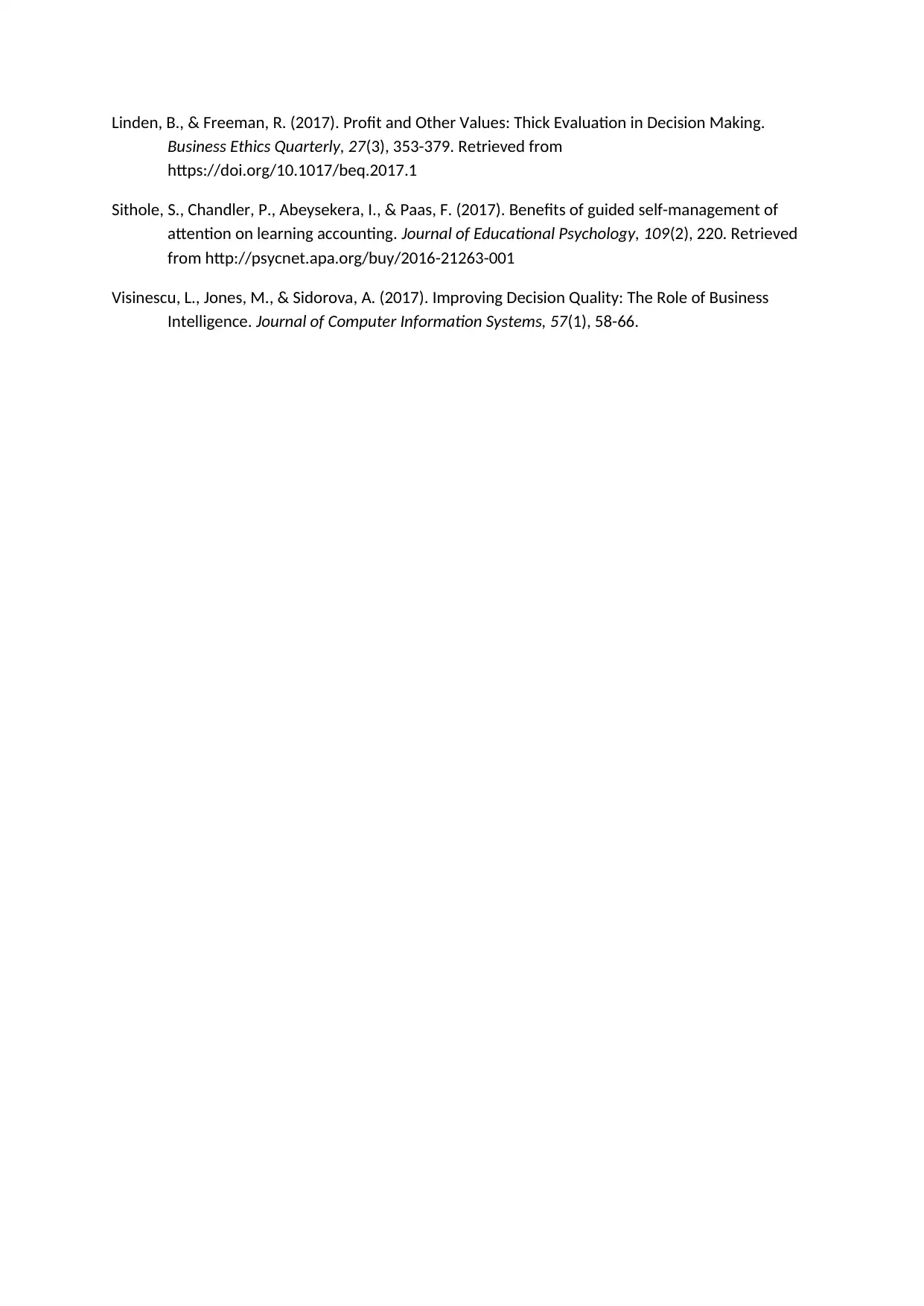
Linden, B., & Freeman, R. (2017). Profit and Other Values: Thick Evaluation in Decision Making.
Business Ethics Quarterly, 27(3), 353-379. Retrieved from
https://doi.org/10.1017/beq.2017.1
Sithole, S., Chandler, P., Abeysekera, I., & Paas, F. (2017). Benefits of guided self-management of
attention on learning accounting. Journal of Educational Psychology, 109(2), 220. Retrieved
from http://psycnet.apa.org/buy/2016-21263-001
Visinescu, L., Jones, M., & Sidorova, A. (2017). Improving Decision Quality: The Role of Business
Intelligence. Journal of Computer Information Systems, 57(1), 58-66.
Business Ethics Quarterly, 27(3), 353-379. Retrieved from
https://doi.org/10.1017/beq.2017.1
Sithole, S., Chandler, P., Abeysekera, I., & Paas, F. (2017). Benefits of guided self-management of
attention on learning accounting. Journal of Educational Psychology, 109(2), 220. Retrieved
from http://psycnet.apa.org/buy/2016-21263-001
Visinescu, L., Jones, M., & Sidorova, A. (2017). Improving Decision Quality: The Role of Business
Intelligence. Journal of Computer Information Systems, 57(1), 58-66.
1 out of 10
Related Documents
Your All-in-One AI-Powered Toolkit for Academic Success.
+13062052269
info@desklib.com
Available 24*7 on WhatsApp / Email
![[object Object]](/_next/static/media/star-bottom.7253800d.svg)
Unlock your academic potential
© 2024 | Zucol Services PVT LTD | All rights reserved.





